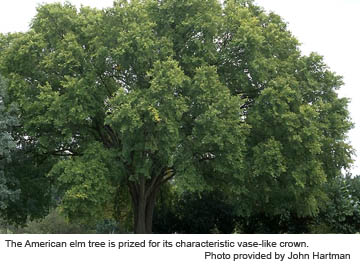Disease-Resistant Cultivars Put American Elm on Comeback Trail
Disease-Resistant Cultivars Put American Elm on Comeback Trail

Could the American elm tree – that once-popular urban shade tree that was ravaged by disease decades ago – be on the verge of a comeback?
With disease-resistant cultivars of American elm now available, odds are yes, according to John Hartman, plant pathologist with the University of Kentucky Cooperative Extension Service.
“If people aren’t afraid to plant it,” said Hartman, who is among a group of UK plant pathologists, entomologists and horticulturists testing many of the new elm cultivars on the UK campus. “Many of us remember when they all died. We don’t want to see that happen again, so some might be worried about that.”
The source of the angst is Dutch elm disease, a fungal disease spread by the elm bark beetle. The disease devastated whole populations of the American elm beginning in the 1930s. In Kentucky, where the tree is native, most were lost during the 1960s and 1970s.
“One of the things that happened with one of the original plantings of American elms was we made the mistake of planting too many of them; in other words, having uniform plantings of elms throughout whole cities. When the disease ran through it, it was pretty devastating,” Hartman said.
There has been increasing demand in recent years for American elms with resistance to Dutch elm disease. Several new cultivars have been introduced, including Valley Forge and New Harmony, which have “excellent” disease resistance, and Jefferson and Washington elms, which are National Park Service selections, Hartman said.
Seventeen of the new elm cultivars are being tested at UK as part of a national elm cultivar trial. Although UK’s trial is still in the early stages, Hartman said much has already been learned about the trees.
“Although all are supposed to be resistant to Dutch elm disease, we already know which ones are attractive to Japanese beetles and elm leaf miners, for example,” he said. “As the trees mature, they will be evaluated for their form and stature and for their fall color.”
In the meantime, Hartman said it is a good time to introduce some of the new American elm cultivars into landscapes and along streets, “at least on a trial basis.”
He advises using the 10-20-30 rule of tree-planting: “No more than 10 percent of the same species, no more than 20 percent of the same genus, and then no more than 30 percent of the same family.”
“You don’t want to have more than 10 percent American elms in any particular city because if a new strain of the fungus comes along, then instead of losing all our trees, we’re only going to lose 10 percent,” Hartman said.
The American elm is native to the eastern United States and survives as far west as the Rocky Mountains. It is prized for being adaptable to harsh urban settings.
“But I think the main thing is it has this very graceful, vase shape,” Hartman said. “It doesn’t have a lot of lower branches that interfere with what’s going on along the street, but it does provide a nice shade by spreading out at the top.”
“American elm was the best of the urban street trees,” he added. “Let’s hope they can make a comeback.”